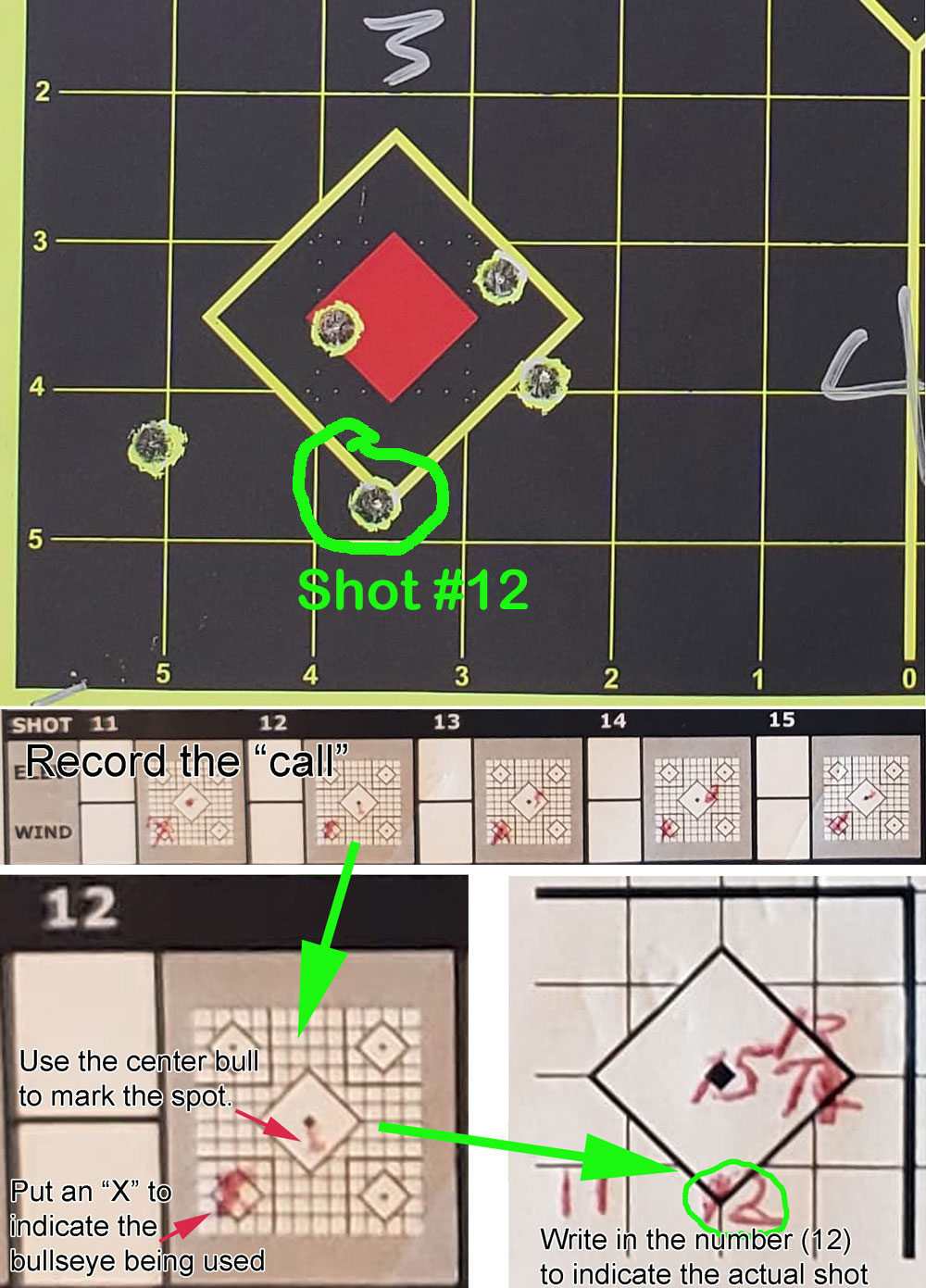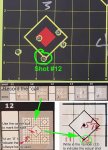I'm not a total noob to precision shooting, but I'm evolving down this rabbit hole.  And, I'm glad to have found this forum!
And, I'm glad to have found this forum!
I've learned that I "must have" a data book, if I'm to improve as a shooter.
I recently bought a Impact Data Books book. It's a very nice bit of kit! I custom-ordered the "modular" book. I like that IDB offers such a variety of target pages, including my favorite types of targets. IDB's website is also well-organized and easy to use / place orders.
I watched the IDB video. Last weekend I went out to "christen" my data book. The range was 200 yards, so not very far.
It wasn't my best day of shooting, really. RPR 6.5CM with Hornady Black 140-gr. I don't know if it was me or the ammo. The Hornady Black has performed very well for me in the past for closer range practice "on the cheap." Maybe this lot was different? Maybe I just wasn't on today. But, in some ways, it made it easier to plot my shots in the data book. (ETA: I discovered my bipod mount was LOOSE after the shooting session. So, THAT'S my excuse!
 )
)
Data book on the firing line:
(love the bungee-cord page tie-downs to prevent them blowing in the wind... or getting flipped by the muzzle blast from the .338-Lapua with a muzzle brake that was in the lane RIGHT next to me!)

I will say that taking notes for EVERY SINGLE SHOT takes TIME. It slows you down a LOT. I'm not implying it's a bad thing. I ended up getting 80 shots in. But, it took WAY longer than my normal shooting pace. I wondered if coming off the rifle between every shot would affect groups. Never minding my less-than-stellar groups, my initial impression is that it DID NOT (affect my groups). I'm pretty confident with my ability to re-establish a consistent cheek weld at this point. If anything, slowing down may actually / eventually improve my groups... maybe. Time will tell.
And, that brings me to the first challenge with the data book. I'm using the Shoot-N-C 12" Targets w/ 5 Squares targets. Love them for precision shooting! I like shooting 5-shot groups for each of the bullseyes. Here's the challenge: Plotting a TINY dot to accurately represent my "calls" on the left side was near impossible, because the target graphics in the call side of the page are quite small, making the 5 individual squares REALLY small. The corner bullseyes are really tiny on the call targets on the left side of the page. Then, I improvised a different way of doing it. I used the center bullseye to chart the call and put an "X" on the corresponding corner bullseye to represent which bullseye I was shooting. (See photos below)
I'm open to any suggestions (and would love to see how you experienced guys do it!
If it was a traditional large round target with a single bullseye, it would obviously be easier. But, if I use a large single-bull target, 5-shot groups are impractical. With the target frames we're using, at best, I could put up two targets. That means I would only get off 10 shots per 25-30 minute "hot" sessions. Of course, at longer distances, I would be using a larger single bullseye type, which will make plotting much easier.
Another question I have is how to chart the shots on the main target (right side of IDB page) when you have tight groups... the numbers tend to run into each other or on top of each other.
The other challenge, not related to the data book pages.... which I think is true for many novice precision shooters, is calling the shot accurately on a consistent basis. For MOST of the shots, I THOUGHT my call was dead-center. At least that's how it felt. For a few really wide shots, I WAS able to call it wide.
Anyway... I shall bear my ballistic soul and share what I did with the data book target pages. I'm open to suggestions, of course!





Here's a close-up of my chart entry "technique." This was for the shot at the bottom of the diamond. Again... I'm open to suggestions. Demonstrations even better! Post your pages!

I used a Rite-in-the-Rain pen, which has a somewhat wide point / nib. I just ordered some ultra-fine tip Sharpie markers to see how they work. My poor handwriting doesn't help!
Thanks! Looking forward to hearing from the esteemed denizens of Sniper's Hide!
I've learned that I "must have" a data book, if I'm to improve as a shooter.
I recently bought a Impact Data Books book. It's a very nice bit of kit! I custom-ordered the "modular" book. I like that IDB offers such a variety of target pages, including my favorite types of targets. IDB's website is also well-organized and easy to use / place orders.
I watched the IDB video. Last weekend I went out to "christen" my data book. The range was 200 yards, so not very far.
It wasn't my best day of shooting, really. RPR 6.5CM with Hornady Black 140-gr. I don't know if it was me or the ammo. The Hornady Black has performed very well for me in the past for closer range practice "on the cheap." Maybe this lot was different? Maybe I just wasn't on today. But, in some ways, it made it easier to plot my shots in the data book. (ETA: I discovered my bipod mount was LOOSE after the shooting session. So, THAT'S my excuse!

Data book on the firing line:
(love the bungee-cord page tie-downs to prevent them blowing in the wind... or getting flipped by the muzzle blast from the .338-Lapua with a muzzle brake that was in the lane RIGHT next to me!)
I will say that taking notes for EVERY SINGLE SHOT takes TIME. It slows you down a LOT. I'm not implying it's a bad thing. I ended up getting 80 shots in. But, it took WAY longer than my normal shooting pace. I wondered if coming off the rifle between every shot would affect groups. Never minding my less-than-stellar groups, my initial impression is that it DID NOT (affect my groups). I'm pretty confident with my ability to re-establish a consistent cheek weld at this point. If anything, slowing down may actually / eventually improve my groups... maybe. Time will tell.
And, that brings me to the first challenge with the data book. I'm using the Shoot-N-C 12" Targets w/ 5 Squares targets. Love them for precision shooting! I like shooting 5-shot groups for each of the bullseyes. Here's the challenge: Plotting a TINY dot to accurately represent my "calls" on the left side was near impossible, because the target graphics in the call side of the page are quite small, making the 5 individual squares REALLY small. The corner bullseyes are really tiny on the call targets on the left side of the page. Then, I improvised a different way of doing it. I used the center bullseye to chart the call and put an "X" on the corresponding corner bullseye to represent which bullseye I was shooting. (See photos below)
I'm open to any suggestions (and would love to see how you experienced guys do it!
If it was a traditional large round target with a single bullseye, it would obviously be easier. But, if I use a large single-bull target, 5-shot groups are impractical. With the target frames we're using, at best, I could put up two targets. That means I would only get off 10 shots per 25-30 minute "hot" sessions. Of course, at longer distances, I would be using a larger single bullseye type, which will make plotting much easier.
Another question I have is how to chart the shots on the main target (right side of IDB page) when you have tight groups... the numbers tend to run into each other or on top of each other.
The other challenge, not related to the data book pages.... which I think is true for many novice precision shooters, is calling the shot accurately on a consistent basis. For MOST of the shots, I THOUGHT my call was dead-center. At least that's how it felt. For a few really wide shots, I WAS able to call it wide.
Anyway... I shall bear my ballistic soul and share what I did with the data book target pages. I'm open to suggestions, of course!

Here's a close-up of my chart entry "technique." This was for the shot at the bottom of the diamond. Again... I'm open to suggestions. Demonstrations even better! Post your pages!
I used a Rite-in-the-Rain pen, which has a somewhat wide point / nib. I just ordered some ultra-fine tip Sharpie markers to see how they work. My poor handwriting doesn't help!
Thanks! Looking forward to hearing from the esteemed denizens of Sniper's Hide!
Attachments
Last edited:




